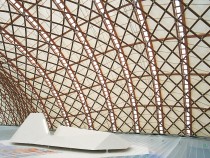
© Christian Schittich
However disappointing many of the exhibitions at?Expo?2000?may?seem,?with?their?over-reliance?on?electronic?screens,?one?redeeming feature may be found in the architecture of some of the national pavilions. Even before the exposition had opened, the Japanese pavilion by the Tokyo architect Shigeru Ban attracted a great deal of attention. It is constructed of cardboard tubes roughly 12 cm in diameter and covered with a special white membrane. The materials will be recycled after use. The festive mood evoked by this lightweight double-curved planar structure is most pronounced in the interior, where an almost meditative atmosphere is created. The Finnish pavilion also manages to convey a lasting impression with simple means and without lapsing into folklore. The dark timber facade cladding may seem unusual, but otherwise the concept of the building fits the image of reserved Nordic charm that one associates with this country. Large areas of printed glass allow only a vague impression to be gained from the outside of the birch wood planted in the interior. The architect, Antti-Matti Siikala from Helsinki, designed the structure in two tracts, which are linked by timber bridges and stairs. Visitors move between the two sections at treetop height. (Ulf Meyer)














